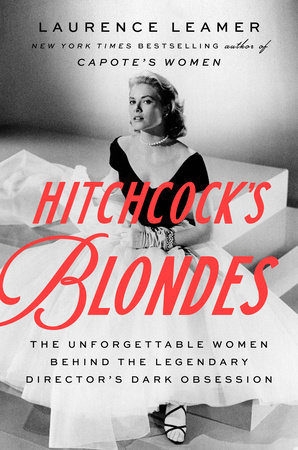Hitchcock’s Blondes: The Unforgettable Women Behind the Legendary Director’s Dark Obsession
- By Laurence Leamer
- G.P. Putnam’s Sons
- 336 pp.
- Reviewed by Therese Droste
- January 24, 2024
A psychological portrait of eight actresses who captivated the auteur.

“I suppose the first blonde who was a Hitchcock type was Madeleine Carroll.”
– Alfred Hitchcock
You may already know many of Alfred Hitchcock’s famous onscreen moments. Eva Marie Saint hangs off Mount Rushmore in “North by Northwest.” Predatory avians attack Tippi Hedren in “The Birds.” A showering Janet Leigh gets stabbed to death in “Psycho.” Grace Kelly is cornered in a killer’s home in “Rear Window.” Kim Novak falls from a bell tower in “Vertigo.” Ingrid Bergman sneaks into a Nazi’s wine cellar in “Notorious.” Madeleine Carroll is handcuffed to her co-star and dragged through rugged terrain in “The 39 Steps.” And June Tripp walks into a suspected murderer’s bedroom in the silent film “The Lodger.”
Onscreen, Hitchcock kept his audiences on edge; offscreen, he ratcheted up the tension on his stars. In Hitchcock’s Blondes, seasoned biographer Laurence Leamer takes these eight actresses and shows us how working for Hitchcock had both negative and positive consequences on their careers and personal lives. “Hitchcock took what in real life would likely have been considered a sick fixation on the icy, unattainable blond woman and turned it into a central part of his artistic dream,” he writes.
In short, Hitchcock was a Professor Higgins who took pride in scouting out talent and molding young actresses to play flawed women. Yet he was also a sexually stunted schoolboy who told filthy jokes to get a rise out of any women within earshot and was psychologically — and physically, when shooting scenes — cruel to the ones he so wished to possess.
Hitchcock’s treatment of Hedren in “The Birds” provides the best example. Leamer starts his book with the ironically titled chapter, “A Fairy Tale,” which describes how Hitchcock’s costly mechanical birds didn’t give the director the “horror” impact he sought in the film. So, instead, he inflicted horror on its star.
After five days of shooting one of the final scenes, which required Hedren to open an attic door, the crew attached live birds by rubber bands, feet first, to her wrists. The birds, trained to claw a person, almost pecked her eyes out. Writes Leamer in a later chapter:
“They assail her in a vicious, prolonged manner akin to rape. The only sound is the thrashing of their wings as the assault seems to go on forever, cutting her face, arms, and legs…The birds’ attack on [Hedren] is the most controversial scene Hitchcock ever filmed.”
Even after this abuse, Hedren made a second Hitchcock movie, “Marnie.” She then retreated from Hollywood and now lives on a wildlife preserve in California. “Hedren blamed Hitchcock for almost everything bad in her life,” writes Leamer. I think in today’s parlance, we might call it post-traumatic stress disorder.
The chapters on Saint, Bergman, Novak, and Kelly are captivating and not as horrifying as Hedren’s. Leamer offers mini biographies of each woman, bringing to bear his decades of talent as an author. In addition to a team of researchers helping him on Hitchcock’s Blondes, Leamer personally interviewed Saint and Novak, as well as Hedren’s former stepson John Marshall. (Leamer is currently riding a high: His last book, Capote’s Women, now streams on Hulu and other channels as the limited series “Feud: Capote vs. the Swans,” starring Naomi Watts, Jessica Lange, and Susan Sarandon.)
When it came to ingenues, Hitchcock had his favorites, and Bergman topped the list. (Given that Leamer also penned As Time Goes By: The Life of Ingrid Bergman, it’s no surprise he shines when writing about the Swedish actress, who was orphaned as a child and seemingly spent her life in search of love from men.) Alas, when Bergman left her husband after becoming pregnant by Italian director Roberto Rossellini, she was banned from making movies in America. Hitchcock was heartbroken when he couldn’t cast her in “Dial M for Murder.”
Enter Grace Kelly.
In Hitchcock’s Hollywood, men ruled and women often suffered, and Leamer doesn’t shy away from the verbiage of the time. Perhaps he should have. When director George Sidney suggested Novak for a role, Leamer writes, he told Hitchcock that “she has a façade and the equipment of a bitch in the long shot. Yet when you look in Kim’s eyes in a close-up, she’s like a baby. There is a fire with the sweetness, a bitchery with the virtue, all in one package.”
Here’s Leamer describing Kelly when she was in high school (high school!):
“Later, when they met with their buddies, they described just how far they had gotten. Had they copped a feel? Unhooked a bra? Got their finger far below? Or stripped to accomplish anything short of sexual intercourse? They knew just how far the girls at Stevens would go, and few went as far and as often as Grace, who enjoyed it as much as the boys.”
Unfortunately, the ick factor and overtly sexist wording distract from what is otherwise good storytelling. Unsettled, I had to put the book down and shudder after reading such passages, and it took away some of the book’s pleasure. The gratuitous language felt voyeuristic at best and slut-shaming at worst.
Still, I’m glad I picked it back up again and finished it. The book contains gobs of juicy material and is easy to sink into. Yes, the writing rambles at times, but that gives it the feel of sitting around the family dinner table and listening to an older relative tell her life’s story. That her life happens to have included Alfred Hitchcock makes the story all the more interesting.
Therese Droste is a Washington, DC-based writer and member of the Independent’s board of directors. Her work has appeared in the Washington Post, Prevention, Health, Washingtonian, and numerous other publications.

